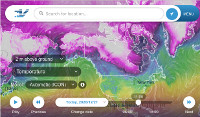Why this blog?
Until this moment I have been forced to listen while media and politicians alike have told me "what Canadians think". In all that time they never once asked.
This is just the voice of an ordinary Canadian yelling back at the radio -
"You don't speak for me."
email Kate
Goes to a private
mailserver in Europe.
I can't answer or use every tip, but all are appreciated!


Katewerk Art
Support SDA
Paypal:
Etransfers:
katewerk(at)sasktel.net
Not a registered charity.
I cannot issue tax receipts
Favourites/Resources
Instapundit
The Federalist
Powerline Blog
Babylon Bee
American Thinker
Legal Insurrection
Mark Steyn
American Greatness
Google Newspaper Archive
Pipeline Online
David Thompson
Podcasts
Steve Bannon's War Room
Scott Adams
Dark Horse
Michael Malice
Timcast
@Social
@Andy Ngo
@Cernovich
@Jack Posobeic
@IanMilesCheong
@AlinaChan
@YuriDeigin
@GlenGreenwald
@MattTaibbi
Support Our Advertisers

Sweetwater

Polar Bear Evolution

Email the Author

Pilgrim's Progress

How Not To Become A Millenial

Trump The Establishment
Wind Rain Temp

Seismic Map

What They Say About SDA
"Smalldeadanimals doesn't speak for the people of Saskatchewan" - Former Sask Premier Lorne Calvert
"I got so much traffic after your post my web host asked me to buy a larger traffic allowance." - Dr.Ross McKitrick
Holy hell, woman. When you send someone traffic, you send someone TRAFFIC.My hosting provider thought I was being DDoSed. - Sean McCormick
"The New York Times link to me yesterday [...] generated one-fifth of the traffic I normally get from a link from Small Dead Animals." - Kathy Shaidle
"You may be a nasty right winger, but you're not nasty all the time!" - Warren Kinsella
"Go back to collecting your welfare livelihood. - "Michael E. Zilkowsky
From the HuffPo (need I say more?) item linked-to in there, “Shift To Green Economy Would Create 4 Million Canadian Jobs: Report”
– And yep – it would, too. Mind you, this really means that, to have the same amount of electricity we get now (only generated by renewables instead of what we use now) would require 4 million more people than what the industry employs at present. And guess where their wages will come from?
Watts Up With That did a breakdown on this, not all that long ago. IIRC, fossil-fuelled electricity was the cheapest, employing the fewest people. Hydro was REAL cheap, but building the power dams is real expensive. Renewables? – what with manufacture, installation, maintenance, frequent replacement and (lest we forget) the 100% back-up needed for whenever the sun don’t shine and the wind don’t blow, was MASSIVELY labour-intensive.
I call ten-times our present awful power rates – and surely we don’t need to imagine any of this; just ask anybody from Ontario…
The article doesn’t tell you everything about exceedingly high energy costs in places such as Australia. I was in Queensland 2 years ago for 6 weeks. Their main energy draw is air conditioning. Problem number one is they have demand meters and energy costs vary during the day. Where I was, Cairns and Townsville, the humidity level is so high that clothes doesn’t dry outside, even on a +35°C day. If they run the dryer at peak times, the cost goes through the roof. And they don’t have large USA style dryers like we do; they’re smaller Asian models. They need to run three time as long as ours for an average size load. All power is 240 Volts 50 HZ.
Keep in mind that the price shown on Eaun’s chart are is in USA dollars. I USA dollar = $1.26 AUD.
If you’re a couple and you’re off to work during the day, you’re OK. If you’re at home and the dryer and AC are on at peak times, look out. At night, it barely cools down, the AC stays on. In spite of an increase in privately owned solar panels that work well at 15° latitude, they don’t work at night, and in areas prone to cyclones, insurance is outrageous..
Add to that the odd gecko that enters an AC unit or outdoor electrical panels (most panels are outdoors) looking for bugs and you have fun resetting breakers that won’t stay on because it’s too hot.
Sask Power looks pretty good after all.
Thankfully Canada never made the list?
Our all in cost is $0.18 kWh , 4 adults in a 700ft2 bungalow.
Sask Power is at 14.7 cents for residential. Slightly cheaper for agricultural.
We get our power from the coal powered Poplar River Station at Coronach, Sk. They say if you look inside the firebox, you see little red devils dancing on the blades of a melting wind turbine while others are stoking the fire.
If you can trust this site Sask isn’t too far behind Ont for AVERAGE monthly costs. Sask urban municipalities levy a 5% tax on your power and your gas bills and that’s just one factor that increases your monthly bill. By the way Quebec residents pay about half of what Sask and Ont residents pay.
http://www.ontario-hydro.com/electricity-rates-by-province
Here’s a typical Sask power bill:
Basic charge-30.07
Cost of electricity-.132/kW.h
GST-5%
PST-6% (this is cute) It’s cost x 5% PST(the former rate before the last budget)=total. Then that total is assessed at the new prov rate of 6% making an effective provincial tax take of 6.3%.
oops I forgot to add the urban municipal 5% charge. Anyway you get the picture.
nold;
Using your numbers and my last Fortis usage it appears you are paying 16.1 cents/kwh. My rate here in B.C. worked out to 13.1 cents/kwh. My use was 2240 kwh over 60 days. These rates were with all tax included. Yearly average: 2014: 0.127; 2015: 0.131; 2016: 0.137 cents/kwh
* GST only in B.C.
* Fortis residential rates are substantially higher than BC Hydro and business gets a rate break.
Very glad I own Fortis stock. 🙂
Just curious ….. on the graph for electrical costs why no China or India or Canada or Mexico for that matter? It’s a pretty Eurocentric chart/graph.